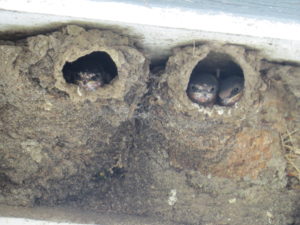(by Pam Hunt)
Because of significant declines since the 1980s, the Cliff Swallow was listed as Threatened in NH in 2017. Surveys conducted in 2017-20 led to me estimate the statewide population at 150-200 pairs, spread across 20-25 colonies (for comparison, there were over 80 colonies in the early 1980s). This decline is also seen elsewhere in northeastern North America, and there is increasing interest in determining the causes of these regional declines. The causes of aerial insectivore (swifts, swallows, flycatchers) declines are still largely unknown, but could include insect declines, agricultural intensification, and climate change, with all factors potentially operating across the species’ full annual cycles.

Because it’s not easy for NH Audubon to conduct research in South America, where Cliff Swallows spend the winter, the first step in understanding their decline is to investigate what’s happening here during the breeding season. If local Cliff Swallow colonies are successfully producing fledglings, it’s less likely that they are limited by threats such as reduced prey or extreme weather events, which in turn would lead us to consider impacts during migration or winter. Sorting all these things out takes time and effort, and to this end NH Audubon initiated a Cliff Swallow study in 2021.
The study focused on two colonies in the town of Tamworth, which combined supported 26 pairs of swallows over the summer. As of the end of August, I estimate that 70% of the nests in each colony successfully fledged at least one young, which suggests – at least initially – that they were not significantly affected by weather or food limitation. Two colonies in one year, however, do not provide enough data to make sweeping conclusion, and our goal is to continue the study for multiple years and expand it to include more colonies. Of particular interest is Pittsburg in far northern NH, where as much as 25-40% of the state’s population occurs.
A few other findings from 2021 are of note. Despite reduced foraging opportunities during the cold and rainy period near July 4th, there was not any sign of widespread nest failure in early July. However, just after the weather improved, five pairs commenced new nesting attempts at one colony, which indicates that they were failed breeders from elsewhere (Cliff Swallows never produce two broods). As this summary is being written, the last of these nests still has a single chick, which is likely to finally leave the nest by the very beginning of September. This is exceptionally late for a Cliff Swallow in NH: the latest date for a nest with young during the 1980s Breeding Bird Atlas was July 16.
By mid-September, even lingering breeders like these Tamworth birds will have largely left the state for points south, and they won’t be back until May of 2022. When they arrive back in the Granite State, NH Audubon will be ready to launch our second season of this study – stay tuned to see what we find.
